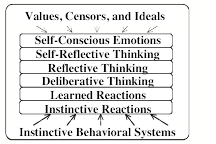§1-6. Adult Emotions
Behold the child, by nature’s kindly law,
Pleas’d with a rattle, tickl’d with a straw:
Some livelier plaything gives his youth delight,
A little louder, but as empty quite:
Scarfs, garters, gold, amuse his riper stage,
And beads and pray’r books are the toys of age:”
Often, when a young infant gets angry, that change seems as quick as the flip of a switch.
A simple theory of how this might work would be that some separate ‘instincts’ compete until just one of them takes over control. However, that model cannot explain how, later, that child finds new ways to deal with frustration:
This suggests that usually, in the infant brain, only one
We tend to regard a problem as ‘hard’ when we’ve tried several methods without making progress. But it isn’t enough just to know that you’re stuck: you’ll do better if you can recognize when you’re facing some particular type of barrier, impasse, or obstacle. For if you can diagnose what

The simplest version of such a scheme would be almost the same as an
However, in a
Of course, we’ll need more specific ideas about how each of those new Ways to think might work, and about how we come to develop them. We know that throughout our childhood years, our brains pass through multiple stages of growth, and Chapter §5 will conjecture that this results in at least these six levels of mental procedures.

Thus, an adult who encounters what might be a threat need not just react instinctively, but can proceed to
We know that these mental abilities grow over several years of one’s childhood. Then why is it that we can’t recollect much of that stretch of development? One reason for this could be that, during those years, we also develop new ways to build memories—and when we switch to using these, that makes it hard to retrieve and interpret the records we made in previous times. Perhaps those old memories still exist, but in forms that we no longer can comprehend—so we cannot remember how we progressed from infantile reaction-sets to using our new, adult ways to think. We’ve rebuilt our minds too many times to remember how our infancies felt!
§1-7. Emotion Cascades
Some habits are much more difficult to cure or change than others are. Hence a struggle may often be observed in animals between different instincts, or between an instinct and some habitual disposition; as when a dog rushes after a hare, is rebuked, pauses, hesitates, pursues again, or returns ashamed to his master; or as between the love of a female dog for her young puppies and for her master, —for she may be seen to slink away to them, as if half ashamed of not accompanying her master.
This chapter has raised some questions about how people could change their states so much.
The Resource-Cloud image suggests that such a change could result when a certain “Selector” excites (or suppresses) a certain large set of resources. Thus Charles’s attraction to Celia becomes stronger when all his fault-finding Critics turn off.

